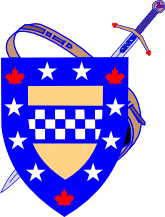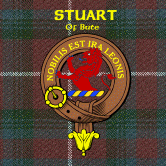Stuart of Bute
| Gaelic Name Stiubbard Clan Motto Nobilis Est Ira Leonis (Noble Is The Wrath Of The Lion) | Plant Badge None Clan Crest Badge A demi-lion rampant Gules, armed and lingued Azure |
The Stewards, or Senechals, of Dol in Brittany came to Scotland via England, when David I returned in 1124. They were created hereditary high stewards of Scotland. By marriage to Marjory, daughter of Robert the Bruce, they acquired the throne on the death of David II. Robert II bestowed upon his younger son, John, the lands of Bute, Arran and Cumbrae. The King erected the lands into a county and conferred the office of hereditery sheriff on his son. The grant was confirmed by charter in the year 1400 by Robert III. James, sheriff of Bute between 1445 and 1449, was succeeded by his brother, William and his grandson, Ninian Stewart. In 1498, James IV created Ninian hereditary captain and keeper of of the royal Castle of Rothesay, an honor still held by the family to this day and which is shown in their coat of arms. He was succeeded in 1539 by his son, James, who in turn was succeeded by his son, John, who attended Parliament in Edinburgh as commissioner for Bute. The family favoured the spelling of their name Stuart introduced by Mary, queen of Scots which the present family still use to this day.
Sir James Stuart of Bute was created a Baronet of Nova Scotia by Charles I in 1727. Early in the civil war, he raised soldiers for the west of Scotland, but was forced to flee to Ireland when Cromwell was victorious. His grandson, Sir James Stuart of Bute, was appointed to manage the estates. He supported the accession of Queen Mary and William of Orange, and later, in the reign of Queen Anne, he was made a Privy Councillor. In 1703 he was created Earl of Bute, Viscount Kingarth and Lord Mount Stuart, Cumra and Inchmarnock
After the successions of George I, the Earl of Bute was appointed Commissioner for Trade and Police in Scotland, Lord leutenant of Bute, and a lord of the bedchamber. His second son, having inherited his mother's estates of Rosehaugh, took the surname Mackenzie. He became a member of parliament. John Stewart, the third Earl, was tutor and confidante to Prince George, later George III. Bute was created a Privey Councillor and First Lord of the treasury. He concluded a treaty with France in 1736 which brought the Seven Years War to an end. When he retired from public life, he built a splendid house at Lutton Hoo in Bedforthshire. His heir, John Lord Mount Stuart, was born in 1767, married the heiress of the Earl of Dumphries. He succeeded his father as Earl of Bute in 1792, and in 1796, he was advanced to the rank of Marquess. The second Marquess consolidated the family fortunes. A noted industrialist, he was largely responsible for modern Cardiff, where he developed the docklands to the greatest coal port in the world. The present chief, better known as the formula one race driver Johnny Dumphries, succeeded his father, the sixth Marquess in 1993. The late Lord Bute was passionately concerned for Scottish heritage, and his efforts were recognized by a knighthood shortly before his death.
The Stuarts of Bute are descended from Sir John Stewart, born between 1345 and 1390. Sir John Stewart was the son of Robert II of Scotland and was known as 'The Black Stewart' (either for his dark complexion or because his brother, John of Dundonald was known as 'The Red Stewart.) The lands of Bute, Arran and Cumbrae were made into a county by Robert III and Sir John was made hereditary sheriff to the lands, as set out in a Royal Charter of 1400.
Septs
- Bannatyne
- Fullarton
- Fullerton
- Jameson
- Jamieson
- MacCammie
- MacCaw
- MacKirdy
- MacLewis
- MacMurtry


